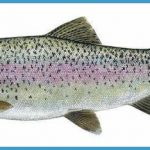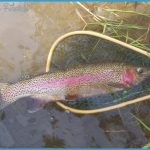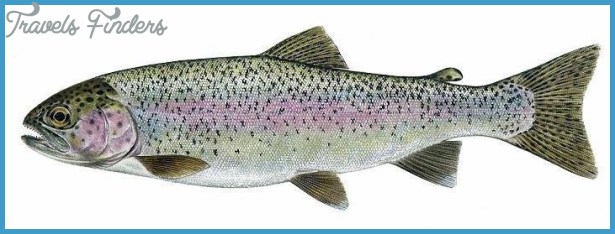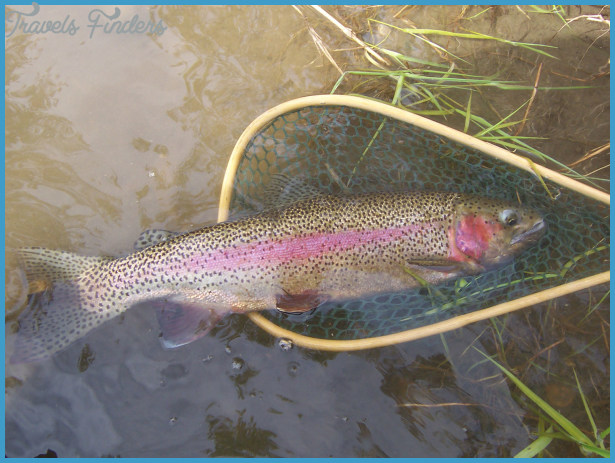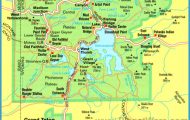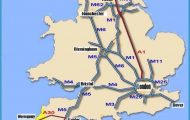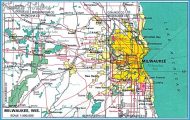Rainbow trout, Salmo gairdneri, are not widespread in Maine, but several waters have well-established populations that offer quality fishing. Maine does not have an official rainbow trout stocking program, but during the last few years, private organizations have stocked rainbows in several Maine waters.
Rainbow trout are prized for their spirited runs and leaping abilities. Also, rainbows are capable of prospering in areas where water temperatures are too high for Maine’s native brook trout.
Rainbow trout are the only Maine salmonids to spawn in spring, not fall. A stream-bred rainbow trout in its spawning colors is a thing of beauty. Instead of the faint trace of red seen in typical anaemic-looking hatchery-reared fish, wild rainbows show their colors in shades of deep rose.
Rainbow trout are active in the early season. Opening day anglers have every chance of taking a rainbow, although low water temperatures can cause the fish to put up a less than exemplary battle. Rainbow trout, like brown trout, feed on bait fish as well as insects, making them popular with a wide range of anglers.
Some Maine waters contain stream-bred rainbow trout. These populations exist because fish from previous stockings have managed to become self-sustaining and because rainbows, a popular game fish in neighboring New Hampshire, have traveled to Maine via streams connecting the two states.
Techniques
Fly casting – Rainbow trout are the fly fisher’s delight. They are taken on streamers, bucktails, nymphs, and dry flies. The same tactics that work on brown trout are effective on rainbows, except that rainbows are more easily taken on colorful attractor patterns such as the Wright’s royal, a variation of the royal coachman with a single hairwing.
In big waters such as the Kennebec River, fly fishers do well with bucktails such as blacknosed dace, and various shades of the Thunder Creek series.
In spring, spawning rainbow trout are fair prey to dry-fly anglers. Rainbows will not forgive a sluggish response, so be prepared to lift your rod the second a fish takes your fly. Spawning rainbow trout can be a real problem when they take to the tributaries. A 16-inch rainbow can make a fast, powerful run. If the stream is small and lined with brush, all the angler can do is hang on and hope for the best.
Fly fishers can take advantage of windy conditions. Look for rainbow trout feeding on the windward side of a lake or pond. The trout are attracted to the myriad insects that float in windrows along the shore. It is almost impossible to fish from shore during these conditions, since casting against the wind is so difficult and frustrating. It is better to use a boat and anchor near the shoreline. Using wet or dry flies, cast with the wind toward the shore. Few anglers like to fish during times of high winds and it can be dangerous when the wind is driving flying spray from the tips of whitecaps, but this is when rainbow trout take to the shoreline. Be sure your boat is big enough to handle the conditions; otherwise, wait for calmer weather.
Use a light- or medium-weight fly rod for rainbows. An 8- or 9-foot rod in 5 or 6 weight is perfect. Do have plenty of backing on your reel in case you hook a big fish; rainbows of 3 pounds and up can make long, line-sizzling runs.
Spin fishing – Rainbow trout are commonly taken on small, gold-colored spoons as well as Rapalas and similar bait fish imitations. Mepps spinners are also effective. This may be the best way to take trophy rainbows in Maine, since the bigger trout prefer fish to insects.
You will need light- or medium-weight spinning tackle; the size of the water being fished will dictate the size of the tackle. If you fish the smaller tributaries, ultralight tackle is the ticket.
Lines need not be more than 6-pound test, and 4-pound test allows for longer and more delicate casts. Do pay close attention to your drag setting, since the initial run of a rainbow trout can be enough to break almost any line if the drag setting is too tight.
Keep your lures small when casting and use the larger sizes only when trolling. Even then, you will have your best luck with the smallest Rapalas and other minnow imitations.
Trout in rivers are likely candidates for the spin fisher using small spinners. Spinners are effective even when rainbow trout are taking aquatic insects from the surface. Cast close to the rise, but not directly on it. Rainbow trout are rarely able to resist the whirring spinner blade as it passes near their feeding station.
Trolling – Rainbow trout will take a night crawler or minnow pulled behind a set of chrome-colored lake trolls. This is a productive way to fish in early summer, when the fish are in deeper water. Go slowly, as you would for lake trout. Fish in
40 to 50 feet of water. You can also use downriggers for rainbows. A good setup is a dodger a few feet in front of a live minnow, Rapala, or streamer fly.
In years past, anglers had success with a June-bug spinner and a night crawler or minnow on the trailer hook. You can duplicate the action of these antique lures by using a snelled hook with a single spinner blade, or even the all-in-one sets consisting of a snap for your hook on the end, a loop for the line on the other, and two spinner blades attached to the wire shaft with clevises. When using this rig, be sure to troll slowly, since the action will be impaired by too much speed.
Bait fishing – Live minnows, garden worms, and night crawlers are all effective on Maine’s rainbow trout. Cast your offering upstream and let it tumble down with the current, just as you would a wet fly.
Best bets for Maine rainbow trout: Wild River, especially near its confluence with the Androscoggin River, Site 13; Kennebec River below Wyman Dam, Site 15; Megunticook Lake, Site 26; and Kennebec River below Shawmut Dam, Site 38.

